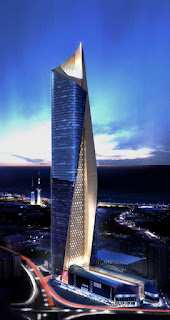Architecture plays a big role in
people's everyday lives because of Kuwait's geographic location. In the past,
buildings were made using the natural resources available at the time. Those
included mud, mud brick, Cora stone, and ruble stone. A historic landmark built
using these resources are the Kuwait Gates. Because of the vast developments
and increase in population, Kuwait became a point of interest in the Middle
East. To secure the safety of the country from danger, the first wall was built
in 1789 and two walls were built after that.
Old Kuwaiti houses were made using
the same materials as the Kuwait walls. In addition to these materials, wood
was imported from East Africa and cut into poles and used for roofs. The
architecture of the house was simple and fulfilled the needs of the people in
the house. There was a courtyard in the middle where the family would usually
get together. Most artistic touches in these houses were found on the main
doors and windows.
In the late 1940s, oil started to
play a bigger role in economic activities. This was a time of great change that
was reflected on the Kuwaiti architecture. Due to this fast change in
development, little of Kuwait's old architecture remains. Also, because it's
located in the middle of the world, many other cultures influence Kuwait's
architectural designs. For example, when the Ottomans were ruling Kuwait, they
had an impact on how Kuwaitis were building their houses. Building balconies
made of wood and inscribing European motifs on the wooden doorways was a direct
influence of the Ottomans.
Since
then, Kuwaiti architecture became very international. The best known Kuwaiti
architectural pieces include the Kuwait Towers and the National Assembly of
Kuwait. The Kuwait Towers are made up of three spheres and three towers. It's a
cultural icon and symbolizes how geographically small countries can achieve
great things. Before building the towers, ten designs were created and only
three were submitted. Pearls and pearl weaving influenced this design. Its
spheres are covered with steel plates of different shades of blue. The mosaic
covered Islam domes and mosques inspired these steel plates. The main materials
that were used in building the towers were concrete, glass, and steel round
plates. This shows how although the materials in the past and present have
changed, the Arabic and Islamic cultural influence are still visible in both
forms of architecture.
More
recently, there has been great popularity in western styled construction. This
can be seen when looking at the shopping malls that are currently being built.
Kuwait is slowly being a center of trade and commerce. Through this, we can see
a lot of skyscrapers being built in the heart of Kuwait City. For example, the
largest sphere shaped skyscraper has just been built in Kuwait City. In
conclusion, Kuwait has had distinguished architectural designs, and will
continue to develop through time.
by Shoug Emad
12 sc 1




